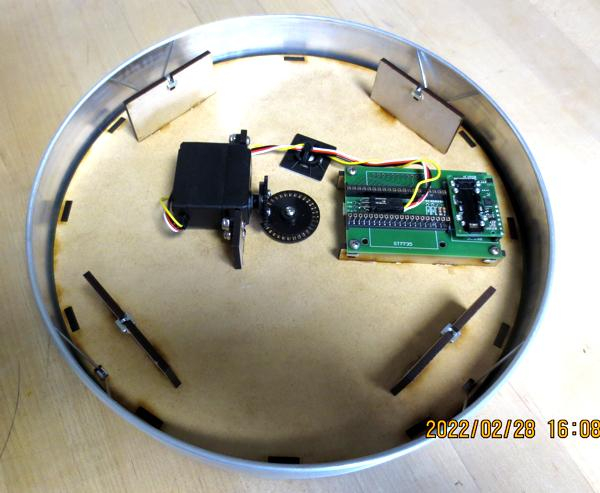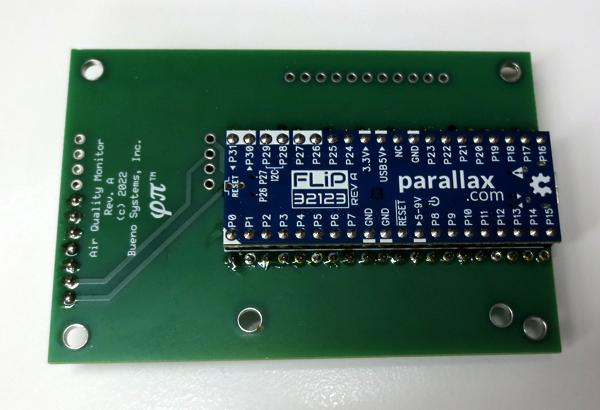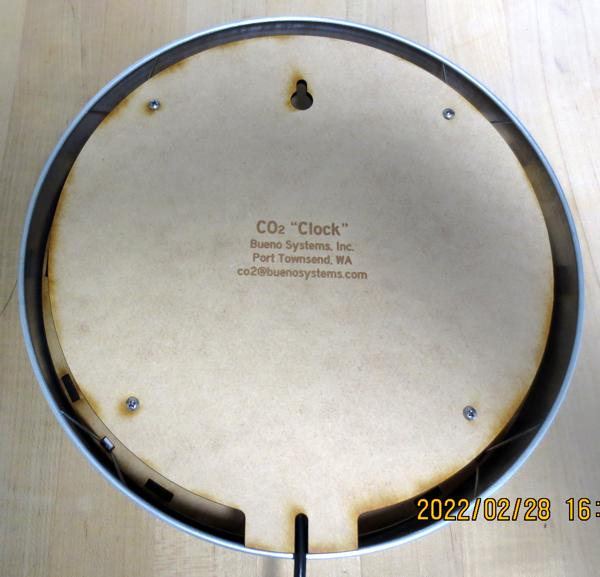CO2 "Clock" Meter
 Phil Pilgrim (PhiPi)
Posts: 23,514
Phil Pilgrim (PhiPi)
Posts: 23,514
Last week I met with some folks (business, government, research) who are interested in monitoring CO2 levels in their businesses, government offices, and schools. The reason has to do with measuring ventilation in crowded conditions and relates to COVID-19. The idea is that if exhaled CO2 can be adequately vented out of a space, any virus-laden aerosols will be vented out, too. Human exhaled breath consists of 4% (40,000 ppm) CO2. The normal outdoor level is closer to 400 ppm. By measuring CO2 levels in a closed space, such as a classroom or restaurant, one can get an understanding of the ventilation system's efficacy.
Anyway, I took my little Air Quality Monitor with me as a demo. It was favorably received, but there was some discussion about a unit that could be read at a distance. I suggested something with a clock face and a pointer that could be read from afar. The group liked the idea, so I promised to build one. Here's the result, next to the smaller meter:

The bezel and lens came from a wall clock I bought at the local hardware store. I really lucked out: it was nearly perfect for this project. I decided to use a Parallax Servo360 to drive the pointer, due to its spot-on accuracy and repeatability. The bezel was not deep enough to accommodate the servo in a direct-drive mode, so I came up with a way to mount it sideways, which I posted about here:
https://forums.parallax.com/discussion/174428/right-angle-drive-for-the-parallax-servo360
I was able to use the same PCB I designed for the small AQ Monitor, which you can see in the guts view here:

It just lacks the TFT display and substitutes a pair of servo headers for the push-button switch. The faceplate is 1/8" MDF with a color-printed dial attached to it. The faceplate, with 12 spacers, is held in place against the glass by four spring clips that came with the clock. You can see one or two behind the vertical supports for the back panel.
Everything is controlled by a Propeller FLiP module, which plugs into the rear of the PCB:

I had to modify the FLiP by removing one of the two layers of insulation from its pins, so the pins would be long enough to reach the connector contacts on the other side of the PCB.
The back panel fastens to its supports with four screws and includes a hang hole and a guide for the USB cable:

This has been a very satisfying project, and I'm anxious to demo it for the folks I met with. First, though, I need a different USB cable -- one with a right-angle micro-B connector, since I did a rather poor job of positioning the PCB, and a straight cable won't fit. I'm also getting some white acetal sheets to cut the pointer from. The one in the photo is black with white paper stuck to it.
What made this project easy are Parallax's two best products: The FLiP module and the Servo360. I can't say enough good things about either of them!
-Phil


Comments
That is really slick, Phil! Nicely done.
WooHoo
That’s awesome Phil! I’d love to build that project. Do you have plans to make that commercially available as a kit or plans?
Paul
Hi Paul,
I haven't thought that far ahead yet. I was thinking of making the PCB available after I make a couple mods to it. It accommodates two different CO2 sensors (SCD30 and SCD41), along with the AdaFruit TFT display. I've written a working driver for the SCD30 in Spin but haven't finished the one for the SCD41. Right now, I just want to get a couple units into the hands of some local folks to try out.
Fortunately, the clock I used is pretty ubiquitous, not very expensive, and easy to disassemble:
https://www.amazon.com/Crosse-Technology-404-2626-Silver-Analog/dp/B016MPFA38
And I wouldn't mind sharing the CAD files for the color print and for the laser cutter. The latter needs to be modified a bit, too. I'm not really satisfied with the way the back plate attaches.
More to come ...
-Phil
I have done some co2 work, and a few questions.
The range you show on the dial, do you really think the meter will ever peg above or below 300ppm-700ppm?
In very closed spaces like a closet, perhaps?
Placement of meter, depending on forced air systems, ideal spot being below the forced air intake? Co2 falls?
Again, the change range found even from many people in a room is likely very low? Due to disturbance, and forced air movement?, Also depends on whether the hvac system is continual, and also variable drive? etc.
So many variables, is there any science on the relation of viral particles and co2? Co2 being the lighter and more mobile, thus the viral load will be a magnitude lower than any co2 detection? Logic would state that the two will move very differently in any given space? Im not hacking the concept, just curious about what you may know about co2 and viral load, other than exhaling one might increase the presence of the other?
Putting one of these meters in any given space presents so many variables.
But I sure can't think of any other way to go about detecting viral load in any given space at any given time.
At least not without some pretty advanced nano-tech.
Nice idea.
In your testing what kind of range do you see?
What kind of hvac systems did you test with?
Do you think a range reduction to the dial (and thus code) would help the user visualize a change better?
To maximize profit, give it a good, warning, danger range, and put a title on it called "COVID Death Risk"
(but make sure you put a disclaimer on the box that says it in no way detects the presence of covid)
You will be selling them like hot cakes, and likely will have a contract with many governments for mass production and mandatory implementation.
Just don't forget me when you are living in a shiny new mansion.
Hi Clock Loop,
In a crowded room with little ventilation, ppms can easily rise into the 1500 range. I once checked my bedroom overnight with the door closed. By morning, the ppms had risen well into the 2000 range. That's an unhealthy level, and I've since been sleeping with the window open -- even in winter.
No, you'd want to place it near where people are gathering in the space to get an idea of what levels they're inhaling.
https://www.ncbi.nlm.nih.gov/pmc/articles/PMC8043197/
-Phil
That pubmed link is excellent, exactly what I wanted...
I wonder if a chemical detector could be made with the furin cleavage sites located on all the covid viruses.
https://www.ncbi.nlm.nih.gov/pmc/articles/PMC7457603/
Or would I be violating the patent by making a detector?
https://weather.com/en-IN/india/coronavirus/news/2022-02-26-new-study-finds-covid-19-dna-linked-to-moderna-patent-filed-in
Navigating the patent system is why I am poor and have never invented anything, I don't have the money to pay lawyers.
I actually had a few ideas in relation to a furin detector, but after seeing all the patent land mines around covid, I promptly stopped.
https://www.nytimes.com/2021/11/09/us/moderna-vaccine-patent.html
https://www.riotimesonline.com/brazil-news/modern-day-censorship/moderna-patented-component-of-coronavirus-three-years-before-pandemic/
I am alarmed that your room got that high, is that forced air? I would bet radiator? If non-forced air systems do that, I am re-thinking that high levels of co2 isn't THAT bad. (not ideal tho)
You sure you don't have a co2 leak?
I am curious if a fart will change/disturb the co2 in the room, since its actually a considerable amount of gas suddenly released.
I wonder how methane affects co2 detectors, if at all.
Apparently, they actually do! And its majority is ... Co2.
https://www.chemistryworld.com/news/explainer-the-chemistry-of-farts/2500168.article
So many variables, so little time. (shakes fist at doomsday clock)
No, baseboard.
It won't affect an NDIR detector, like the one I'm using, since it's selective for the IR absorption peak of the CO2 molecule.
-Phil
Apparently I shouldn't have asked about methane, as only 1/3 of us actually produce it, I edited the above post after you replied apparently.
At least you can joke in your sales pitch that it even detects co2 from the other end, thus covid may also be detected in that way also.
Science is funny, and fun.
This suggests that your meter may best serve in a bathroom (public) which can control the entry of the next person based on measured co2 levels.
I bet you public bathrooms are a key to this spread, since co2 in breath, and flatulence is considerable in those spaces due to the movement of bowels reqiring extra effort increasing respiration rate.
Not to mention, where is the one place people go when they are not feeling so well?
This also suggests that all public restrooms should have an exhaust fan on 24/7 for safe measure.
This gives you a chance to do data analytics, requiring a server and corporation with stock options for public trading.
You measure the data for bathroom use, and co2 levels and if average over a given time(a week?) is increasing, you can deduct that sickness may also be.
Then you can publish a weekly risk value related to millions of public restroom metadata located in the metaverse?
So a bathroom might be a really good pitch also!!!
Again, can I stay in your guest house next to your pool when you buy your mansion?
I can be your party host, and you can pitch ideas that I can hack at. How about a title like, secondary adjunct of philmatrix zero?
How funny can we get with this science?
But all that I have stated is very real, and serious in relation to the topic of the thread, be it funny or funky.
I like science because it forces us to question the absurd and face the hard reality of science.
I had a car that set off all the alarms at the emission testing facility, and when it went off it sounded like a air raid siren.

I think your detector would be best, with the same kind of alarm.
And their alarm was loud too, so make it loud! It was so loud I felt guilty, somehow, because my car was old and I was too poor to get a efficient one.
The volume had a Maximum effect! It made me feel like I started a war with my car.
Who would go into a bathroom with an air raid sound?
Maximum effect.
Maybe it needs facility for remote CO2 sensors ?
That way the meter can be placed where it is best suited, and sensor can be placed for best-CO2 pickup.
With lots of these in adjacent classrooms, maybe wireless is not so useful - maybe InfraRed is good enough to link across a room, and keep inside that room ?
Yes, we talked about that.
That's a thought, as long as a line-of-sight connection can be maintained -- or else a really bright IR source that blankets the room with reflected light.
-Phil
That's really nice Phil, great repurposing of the clock face. Us engineer/scientific types like to see quantitative readings. I cringe when I see the IAQ index for particulate matter and in my head convert back to µg/m^3 or ppm ozone. But an LED bar graph or a single RGB coded signal like the ill-fated Air Quality Egg might serve for many general public purposes. The clock face has class though, and and a look that draws the gaze.
Next will be complications, more dials, for RH/T, CO, and of course a link to your smart watch! (Kidding, KISS)
The big format one I see from CO2meter.com uses a custom character display and costs $500.
https://www.co2meter.com/collections/indoor-air-quality-iaq/products/csense-large-wall-co2-meter
Thanks, Tracy! I wonder if I should make the pointer a little less pointy, though. It implies a level of precision and accuracy that's probably not attainable.
I could flip the board over and cut a window in the dial for the TFT display. But to read it, folks would have to get close enough to breathe on it!
-Phil
A pointer is still useful for showing small trends, but you could place a circular disc on the arm near the pointer, so it is easier to read from a distance ?
Right. I forgot to mention that the unit records its readings (ppm, temp, RH) every five minutes and can store more than two weeks worth of data for later download as a CSV file.
-Phil
@clock loop
Yep, lawyers are costly. But there are many ways around patents. Prior art, certain types of improvements.... So even if you get a patent, you have to enforce it. More lawyers. Have one patent in provisioal status. Employer has a deal, they and their IP do it all. After costs, the Foundation gets big chunk of proceeds, and I get rest. They market, licensce and if needed defend. Better bit of some than all of none.
As to sensor placement, I think best place is return air duct. Since it will be pulling from the whole room, that may give a reasonable average of CO2 levels in the room. Offsets would be things like air leakage to/from windows, electrical sockets etc. depending on whether the ventilation system is adding or loosing air with system leaks. (Had an AC/R instructor heavy on building environmental systems years ago) I could be in the weeds, but a relative level based on a room empty value vs % of room capacity as a range would be a reasonable indicator.
I think this would be a good idea to test because I would be interested in the results because if you could measure it this way and it could be verified by some control testing it could be very useful
One thing to keep in mind is that if you have more than one return duck going to the air handler then you would have to place it where they join together
>
Those are some primo entrepreneurial skills .... I mean, you are right
.... I mean, you are right
I wish I could watch this video properly, damn Rogers (biggest canuck internet provider) outage is hurting more than I would have thought